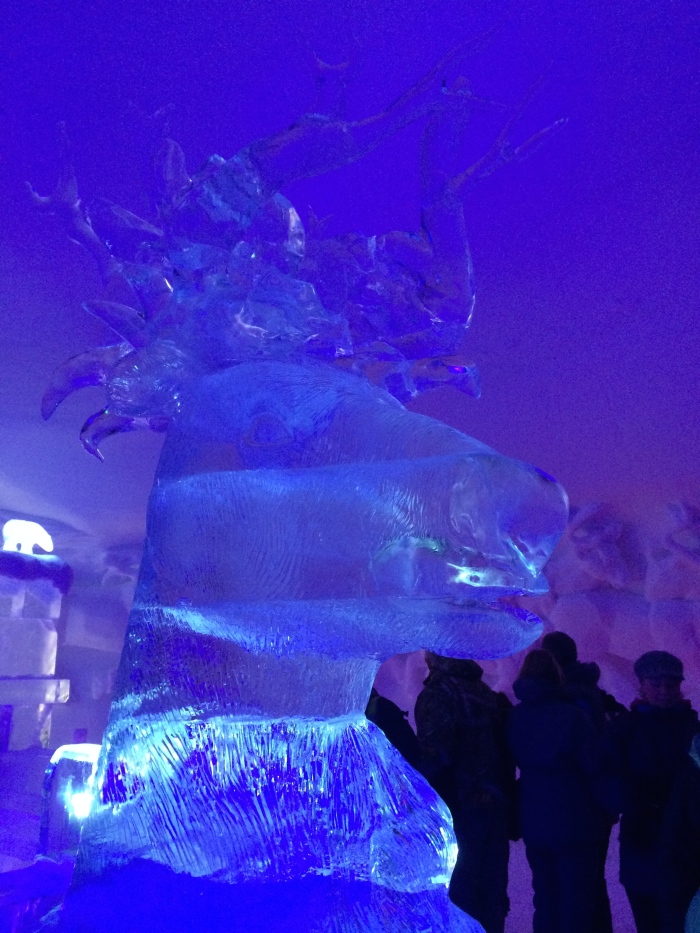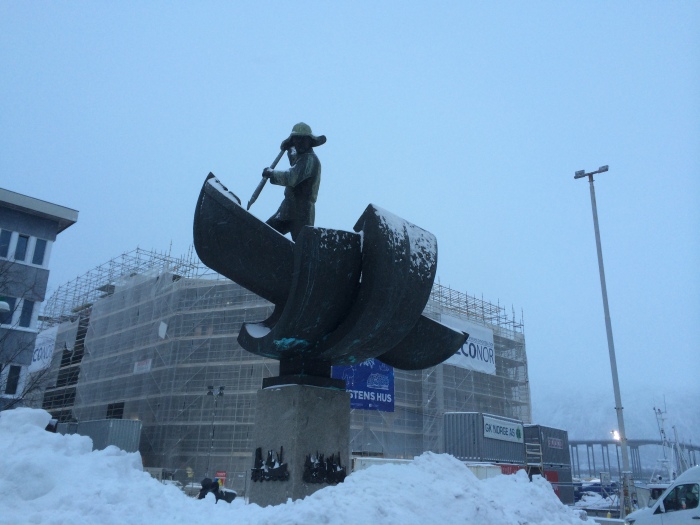In our last hours on Hurtigruten’s MS Nordkapp Saturday, we sailed through Hurricane Ole. It was quite a sickening ride, and both kids hurled. We had bought acupressure bracelets that other passengers had told us about to prevent motion sickness, but they didn’t seem to work great for us. Much of the time onboard was rough water, but that last day was somethin’. We and a hundred-plus others got off the ship in Tromsø (as planned – not because of the storm) just after midnight to check into our hotel and were glad to be on solid ground again, but Monday afternoon I still felt like I was on a boat. Charlie and I spent most of Friday and Saturday afternoon and evening in our bunks and skipped dinner both nights, but Laurel felt a bit better than we and was ambulatory and eating both times (although she lost Saturday’s dinner). Saturday’s dinner was delayed 90 minutes due to dishes falling on the floor, waves hitting the windows of the 4th-deck dining room, and everyone falling over who tried to get to their tables, according to eyewitness Laurel. So…I guess that’s quite enough about motion sickness, but it comprised a substantial portion of our journey.
In my previous blog post I said that the sky was cloudy Thursday night, so we wouldn’t see the Northern Lights that night, but we did! I don’t have any photographic evidence because my iPhone camera doesn’t capture such things or pretty much anything else in low lighting, but it was really cool to see. Shortly after that (about 5 pm) a local fisherman came aboard and showed us some live king crabs that he had caught and told us about fishing them with the Russians. Since northern Norway arches over Sweden and Finland and borders Russia, the Norwegians and Russians are neighbors and in some cases collaborators. A few decades ago, some Russian guy placed king crabs in the ocean along the northern coast of Norway in order to develop a profitable fishing industry in that area. The king crab population exploded and did indeed create a profitable fishing industry, but the crabs are causing environmental harm by eating some of the native fish to near extinction. The Russians allow themselves to catch far more king crabs than the Norwegians even though it’s Norwegian waters. The Norwegian fishermen must present all their catches live to the Russians to be counted and weighed.
Below is a photo of a female king crab and her many thousands of eggs; that brown blob is all eggs.
On Friday morning we docked for a few hours in Kirkenes near the Russian border where we and hundreds of other passengers took buses to the nearby snow hotel. Guests can pay 2500 Norwegian Kroner/$330 per night to sleep in a sleeping bag on top of a mattress on top of a block of ice in a big igloo with 20 guest rooms. Each room has a different snow sculpture/relief on the walls. Every April the hotel melts and is built anew each October. Despite begin in the Arctic Circle, northern Norway isn’t really that cold because of the Gulf Stream. When we were there, highs were in the 30’s and lows in the 20’s – much warmer than the same latitude on the north coast of Alaska and Siberia. After drinking crowberry juice in the hotel bar and touring the rooms, we walked to the breakfast room (in a permanent/wooden structure) where we drank crowberry tea and ate reindeer sausage. We also ate reindeer on the cruise – stew, in that case. Then we walked around outside and fed the reindeer and petted the husky pups before taking the bus back to the ship.
On Saturday we docked in Hammerfest for an hour and 45 minutes. When Laurel was about eight years old, she started writing a novel in which one of the characters was from Norway. She then researched towns in northern Norway and found Hammerfest, the northernmost town in the world. (We’re not really sure why it’s called that since we came to another couple towns north of there although they were smaller than Hammerfest.) She told me at the time about the Germans bombing and burning everything in the city until only the small church and cemetery remained. On Friday we saw that small church – now used for something else – and cemetery. We also toured the post-war museum before hurrying back to the boat. Most of the museum’s signs are in Norwegian, but we used a new feature on Google Translate’s app for some of the signs. Within the Google Translate app, we touched the camera icon which scanned the sign’s words and then translated them – no typing necessary! It’s really cool. It doesn’t always work perfectly and requires good light which the museum doesn’t really have, but we got the gist of it. Ernst, our snow hotel tour guide, had told us a bit about northern Norway’s WW II experiences, including his family’s. He was five years old when the war ended and his family could come out of the mining cave in which they and thousands of others had hunkered down for the final horrible fighting of the Soviets and Germans. He said the Soviets stuck around for nearly a year after the war and helped families rebuild and get medical care and supplies. Then they left – no attempt at making them part of the USSR. I downloaded a book on my phone and am a little ways into it – Vincent Hunt’s Fire and Ice. The elderly Norwegians whom Hunt interviewed said the Germans were there so long that they kind of seemed like family after a while. Many of the local women had affairs with German soldiers. The SS soldiers were a different story though and did unspeakable things to the Soviet POWs they captured and forced to work in many local labor camps that the Germans set up. One of the interviewees said he and his friends saw such awful things as children that most became alcoholics. Their experiences were quite different from those in Oslo and the rest of southern Norway, and there is more than a little resentment on both sides.
Back on the ship when Charlie and I were both lying down, Laurel came into the cabin after a while and sang Led Zeppelin songs with Charlie.
Back on land at last:
Nearly everything, including most of the restaurants, were closed on Sunday in Tromsø; but we were able to get soup at one restaurant for lunch (and gluten-free pizza for dinner!) as well as pay to watch the annual reindeer racing. Reindeer were essential to the lives of the Sami people of northern Norway. Reindeer were transportation, food, clothing, currency.
Sunday night we and hundreds of others on two buses were driven about 90 minutes from Tromsø to escape some of the city lights (although there are many street lights along a bridge as seen in some of the photos) in order to see the Aurora Borealis. I didn’t have high hopes since it was cloudy and snowing all day, and there was also a full moon. However, Arctic Guide Service, who operates the bus tour, got the latest weather information and took us to a great spot. Somehow the clouds cleared completely where we were so we could see the lights but still seemed to cover the moon so we didn’t have that light pollution to obscure the Northern Lights. They took the photos that you see below; my iPhone camera still wouldn’t pick up anything. The camera (the professional one, not my phone) makes the lights look greener than they look in person; but they were still spectacular. The tourists were about 2/3 British, 1/3 Americans. There was one British man in particular whose joy at seeing the lights and accent was so charming. “Dance! DANCE!” he said, mesmerized at the display.
At the Tromsø airport we bought snacks before boarding the plane. I guess the “Hollande” on the passon-fruit-juice label is a reference to French President Francois Hollande’s affair.
























That is AMAZING! What an awesome experience…I hope you’re going to write a book!!!
Will you be going to Denmark?
Amazing pictures!!!! Thank you for sharing :)!!! Travel safe and see you soon :)!!!
I love Charlie’s smile in the hotel on solid ground! Such relief! Thanks for sharing your travels with us!